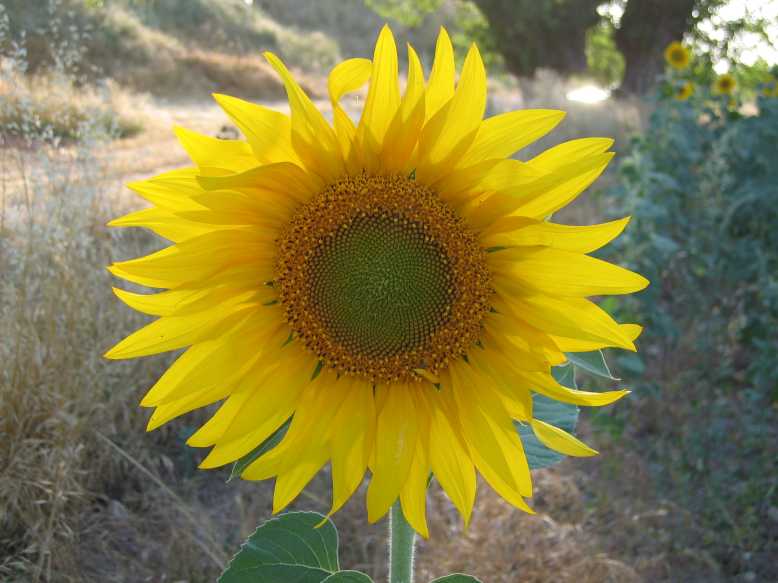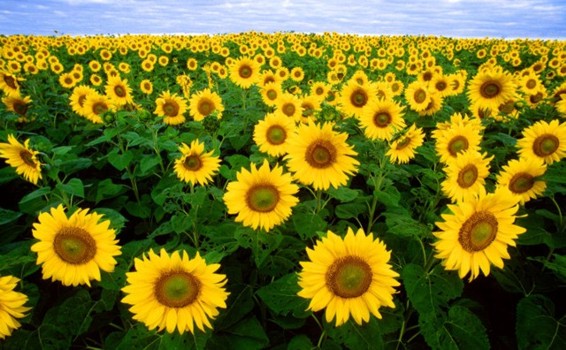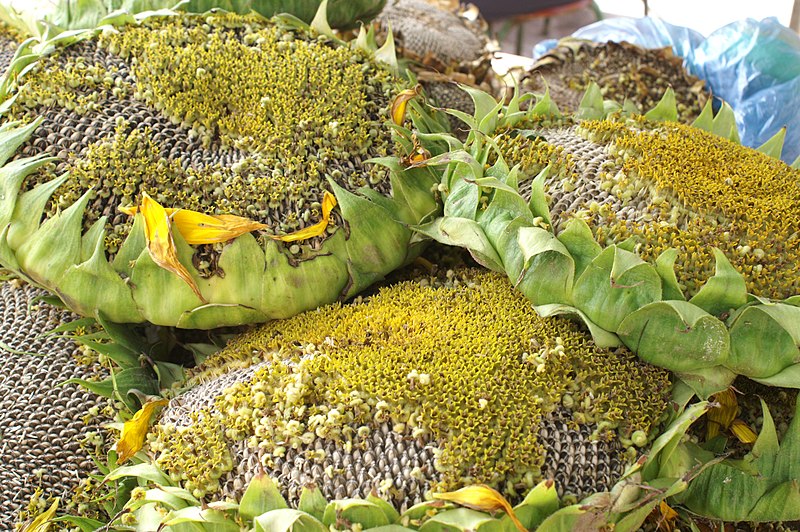The sunflower (Helianthus annuus), also called Caloma, halter, marigold, sunflower, tlapololote, corn tile is a herbaceous plant of the Asteraceae family, cultivated as an oilseed and ornamental plants worldwide. It owes its common name from the fact that its inflorescence turns throughout the day looking at the sun. The inflorescences grow after a stem that can reach several meters in height and has few leaves. The petals can be yellow, brown, orange and other colors.
 <
<
The sunflower is native to the Americas and its cultivation dates back to 1000 BC The earliest evidence indicate that the sunflower was first domesticated in Mexico at least 2600 BC In many Native American cultures, the sunflower was used as a symbol representing the deity of the sun, mainly Aztec and Otomi in Mexico and the Incas in Peru.
Francisco Pizarro found it on Tahuantinsuyo (Peru), where the natives worshiped an image of sunflower as a symbol of their sun god. Gold figures of this flower, and seeds, were taken to Europe in the early sixteenth century.
Helianthus, as it is known scientifically, means "flower that rotates with the sun" in Greek, because of its ability heliotropic.

In Greek mythology there is a water nymph named Clytie, a daughter of the god of the ocean and sea goddess Thetis (titánide). Clytie fell in love with Apollo and watched him daily since he left his palace for the MAN
ana until it reached the west in the afternoon. According to legend, after a few days became a sunflower Clytie and still do not forget the object of his love and follow the sun in its daily journey. Anyway, the word "sunflower" and its cognates existed long before they bring the Helianthus annuus to Europe. Some scholars think that the myth of Clytie, which refers to Ovid's Metamorphoses, actually refers to Heliotropium or Calendula.

The name refers to the flower rotates according to the position of the sun and their training. Plant hormones are those that give positive phototropism of sunflower allow further growth of tissue in one direction, which facilitates the rotation of the plant. Plant hormones control all functions of the plant: growth, fruit ripening, flowering, phototropism, etc.., The best known are the family of auxins (growth and geotropism), gibberellins (cell proliferation), cytokinins (germination and flowering), abscisic acid (lethargy) and ethylene (ripening and flowering). Control of plant hormones is due to the interaction of different factors like the sun, direct light, gravity, heat, the amount of UV rays, or other chemicals related to hormonal or non hormonal.
Pipes or sunflower seeds are usually consumed after a light roast and sometimes slightly salty, are considered very healthy because, as sunflower oil are very rich in dextro α-tocopherol (natural vitamin E) and minerals but you should avoid its intake by young children and can cause choking in them, for their part virgin sunflower oil, but does not possess the qualities of olive oil does have an amount four times more natural vitamin E that olive oil.

The time of sowing for rainfed crop varies with latitude, but it lasts about a month after the start of summer. Planting should be done in rows at 0.70 m, with a density of four plants per linear meter.
It is an undemanding crop in soil type, but prefers sandy clay and rich in organic matter, but it is essential that the soil has good drainage and water table is shallow.
Germination of sunflower seeds depends on the temperature and soil moisture, with the average temperature of 5 ° C for 24 hours.
The depth of sowing is done in function of temperature, humidity and soil type.
* In humid with warm summers and wet with heavy soils, the planting depth is 5-6 cm.
* In areas with dry summers with low humidity and light soils, the planting depth is 7-9 cm.
* If the soil is light and fluffy planting depth is greater, the opposite happens if the soil is heavy
The plants from the planting surface germinate and flower earlier than those from deep sowing.

Some recently developed varieties have heads sagging. These varieties are less attractive to gardeners who raise flowers as decoration, but attractive to farmers because they can reduce damage by birds and plant disease losses.
The sunflower is processed to extract the oil. The flour is left as residue from the extraction of oil serves as food for livestock.


















0 comments:
Post a Comment